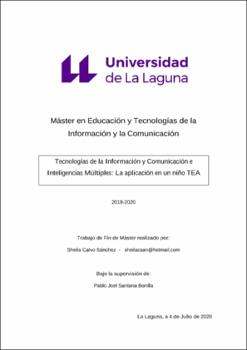Tecnologías de la Información y Comunicación e Inteligencias Múltiples: La aplicación en un niño TEA
Author
Calvo Sánchez, SheilaDate
2021Abstract
El presente Trabajo fin de Máster tiene como finalidad principal estudiar la
incidencia de las tecnologías de la información y comunicación, utilizando las
inteligencias múltiples propuestas por Howard Gadner en un alumno diagnosticado de
trastorno del espectro autista. En el marco teórico hemos realizado, en primer lugar, un
recorrido en el que sintetizamos las características principales del trastorno del espectro
autista. En segundo lugar, describimos como plantean las inteligencias múltiples diversos
autores, y finalmente, reseñamos aplicaciones TIC para alumnado con TEA. Para poder
alcanzar el objetivo principal hemos diseñado y puesto en práctica un programa de
intervención compuesto de actividades basadas en las inteligencias múltiples y con el
apoyo de aplicaciones TIC. De nuestro trabajo podemos destacar tres conclusiones:
utilizar herramientas TIC en la propuesta pedagógica ha sido un acierto ya que ha
contribuido a aumentar el gusto e interés por en el alumno TEA por tales herramientas y
le ha ayudado a realizar mejor las tareas propuestas; el establecimiento de rutinas, y la
anticipación y organización de las tareas han sido claves en el trabajo con el alumno ya
que han contribuido a mejorar su aprendizaje; y, en un grado no menor de importancia,
el apoyo de la familia al aprendizaje de su hijo han ayudado también al logro y mejora de
los aprendizajes. The main purpose of this Master's Thesis is to study the incidence of information
and communication technologies, using the multiple intelligences theory proposed by
Howard Gadner in a student diagnosed with autism spectrum disorder. In order to achieve
this, a view of a theoretical framework based on the main characteristics of autistic
spectrum disorder. Secondly, we describe how multiple intelligences pose diverse
authors, and finally, we review ICT applications for students with ASD. In order to
achieve the main objective, we have designed and implemented an intervention
programme composed of activities based on multiple intelligences and supported by ICT
tools. From our work we can highlight three conclusions: using ICT tools in the
pedagogical proposal has been a success as it has contributed to increase the taste and
interest in the TEA student for such tools and has helped him to better perform the tasks
proposed; the establishment of routines, and the anticipation and organization of tasks
have been key in working with the learner as they have contributed to improving their
learning; and, to a no lesser degree, family support for your child’s learning has also
helped to achieve and improve learning.




